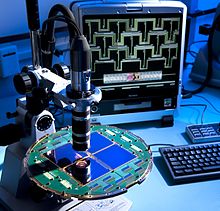BICEP and Keck Array

The BICEP2 detector array under a microscope
|
|
| Location(s) |
Amundsen–Scott South Pole Station |
|---|---|
| Wavelength | 150 gigahertz |
| Telescope style |
radio telescope |
| Website | www |
|
|
|
|
[]
|
|
BICEP (Background Imaging of Cosmic Extragalactic Polarization) and the Keck Array are a series of cosmic microwave background (CMB) experiments. They aim to measure the polarization of the CMB; in particular, measuring the B-mode of the CMB. The experiments have had four generations of instrumentation, consisting of BICEP1, BICEP2, the Keck Array, and BICEP3. The Keck Array started observations in 2012 and BICEP3 has been operational since May 2016.
The purpose of the BICEP experiment is to measure the polarization of the CMB. Specifically, it aims to measure the B-modes (curl component) of the polarization of the CMB. BICEP operates from the Amundsen–Scott South Pole Station. All three instruments have mapped the same part of the sky, around the South Celestial Pole.
The institutions involved in the various instruments are Caltech, Cardiff University, University of Chicago, Harvard–Smithsonian Center for Astrophysics, Jet Propulsion Laboratory, CEA Grenoble (FR), University of Minnesota and Stanford University (all experiments); UC San Diego (BICEP1 and 2); National Institute of Standards and Technology (NIST), University of British Columbia and University of Toronto (BICEP2, Keck Array and BICEP3); and Case Western Reserve University (Keck Array).
...
Wikipedia
